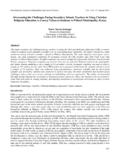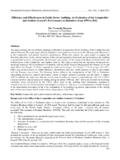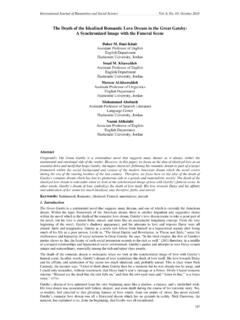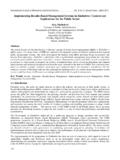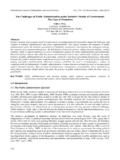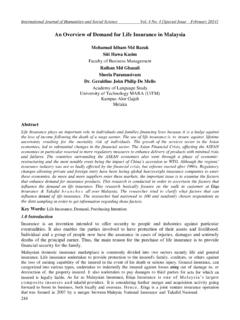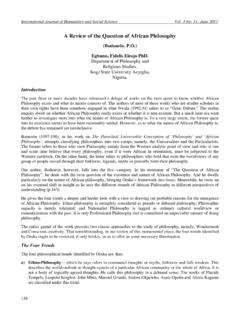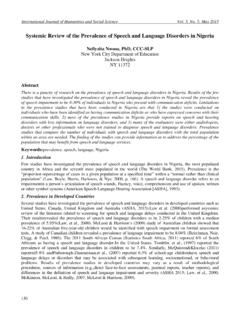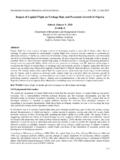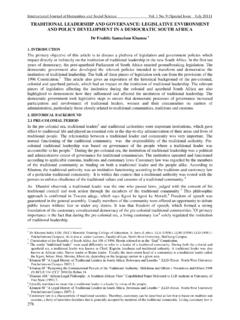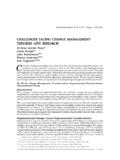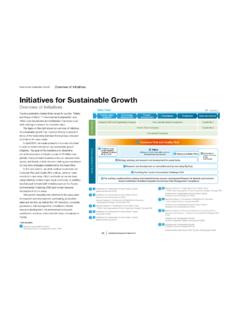Transcription of Relationship between Strategic Human Resource …
1 International Journal of Humanities and Social Science Vol. 2 No. 10 [Special Issue May 2012] 62 Relationship between Strategic Human Resource Management and Firm Performance of Kenya s Corporate Organizations Miss Esther Wangithi Waiganjo, Tutorial Fellow School of Human Resource Development Jomo Kenyatta University of Agriculture and Technology Box 62000-00200 Nairobi, Kenya. Prof. Elegwa Mukulu, Associate Professor School of Human Resource Development Jomo Kenyatta University of Agriculture and Technology Box 62000-00200 Nairobi, Kenya. James Kahiri, Senior Lecturer Department of Mathematics Kenyatta University Box 43844-00100 Nairobi, Kenya. Abstract This paper examines the extent to which Strategic Human Resource management influences firm performance from various critical perspectives.
2 Rapid environmental changes, competition to provide innovative products and services, changing customer and investor demands and globalization have become the standard backdrop for firms. Sustained competitive advantage could be generated from a firm s Human capital by designing Strategic Human Resource management to diagnose a firm s Strategic needs which is required to implement a competitive strategy and achieve operational goals. Effective Human Resource management strategy systematically organizes all individual Human Resource management measures to directly influence employee attitude and behavior in a way that leads business to achieve its competitive strategy. Finally, this article develops a conceptual framework that explains the Relationship between Strategic Human Resource management, competitive strategies and firm performance.
3 Key Words: Strategic Human Resource management, Firm performance, Competitive strategy 1. Introduction Organizations today have increasingly become aware of the importance of Strategic Human Resource management (SHRM).This awareness in a system is a critical dimension in the performance of organizations (Rees, 2006). The real life experiences substantiate the assumption that no matter how sophisticated and modern the business activities of the organization may become, it will be extremely difficult to sustain its growth and effectiveness unless there are strategies that complement its operations. Business competitiveness is a recurring theme examined by academicians, consultants and practitioners. The frequent and uncertain changes, greater competition between firms, the need for continuous innovations, quality enhancement and cost reduction force companies to face the challenge of improving their competitiveness and consequently their performance.
4 This realization has propelled SHRM as a major field of study and the renewed interest has facilitated the development of newer approaches in managing organizations and Human Resource (HR), (Wright, 2005). The Special Issue on Arts and Social Science Centre for Promoting Ideas, USA 63 According to Armstrong (2009), Strategic Human Resource management (HRM) emphasizes the need for the HR plans and strategies to be formulated within the context of overall organizational strategies and objectives and to be responsive to the changing nature of the organization s external environment. It is an approach which requires interpretation and adaptation by practitioners to ensure the most suitable fit between HR business strategies and plans. Thus, the overall themes of SHRM are the integration of all HRM functions, adherence to broad organization goals and responsiveness to the external environment (Armstrong, 2009).
5 There are a number of studies (Appelbaum, 2000; Huselid, 2005; Wright, 2005: Schuler & Jackson, 2001) focusing on the main competitive factors of business organizations because of their contribution in the global economy. The quest for competitive advantage has long been a central tenet of the field of Strategic management (Armstrong, 2009). Within this field, the configurational theory has emerged as a promising new framework for analyzing the sources and sustainability of competitive advantage. In SHRM, internal fit and external fit are the two main research streams. Scholars have long held that in addition to internal organization characteristics, environmental characteristics also significantly influence firm performance since the external environmental characteristics represent customer demands and nature of market competition which are important determinants of firm performance.
6 Background of the Study Corporate organizations in Kenya contribute around to GDP and this has remained largely unchanged since 2004 (Kenya Economic Development report,2009), and are faced with many challenges including rapid environmental changes, competition to provide innovative products and services, changing customer and investor demands, poor infrastructure and globalization. Therefore, they are also faced with major challenges of constantly improving their performance by reducing costs, enhancing quality and differentiating their products and services. The market environment in the country has been extremely turbulent during the past decade, and to maintain continuous success in the face of global competition, firms must identify and analyze environmental characteristics and develop strategies to meet changing market needs.
7 According to Kenya Economic Development report (2009), corporate organizations in Kenya employ 25 % of the labour force and contribute over % of Kenya s gross domestic product. The sector is also among the largest employers in Kenya in addition to the tax opportunities it presents. According to this report, the economies of most successful countries in the world originated from their successful business organizations which drive the economy of the country. These organizations need to respond to greater global imperatives and challenges to compete effectively in local and global markets. Strategic Human Resource Management and Firm Performance According to Armstrong and Baron (2004), people and their collective skills, abilities and experience, coupled with their ability to deploy these in the interests of the employing organization, are now recognized as making a significant contribution to organizational success and as constituting a major source of competitive advantage.
8 The practices of SHRM such as resourcing, training and development, employee relations and reward management are concerned with how people are employed and managed in organizations so as to achieve competitive advantage through the Strategic deployment of a highly committed and capable workforce. Cole (2004) emphasize that the HR function brings in the Strategic value of people in organization by making contribution to value added and contribution to competitive advantage. The organization relies on HR as its employees. Effective HRM strategy systematically organizes all individual HRM measures to directly influence employee attitude and behavior in a way that leads business to achieve its competitive strategy (Huang, 2001). In view of the fact that the goals and the necessities of each of the competitive strategy types are different, the management of HR of the firm should be aligned with the overall corporate strategy.
9 The firm can thus obtain a competitive advantage and thus achieve superior performance (Kelliher & Perret, 2001). There has been a debate by numerous researchers whether SHRM should always be positively related to firm performance. Universalistic scholars argue that there is a universal set of HRM best practices that can maintain a firm s performance (Lau & Ngo, 2004). Contingency scholars hold different points of view and argue that the assumptions underlying the HRM strategy-performance link are applicable only under high external fit conditions, termed the best fit school (Boxall & Purcell, 2000; Bamberger & Meshoulam, 2000). International Journal of Humanities and Social Science Vol. 2 No. 10 [Special Issue May 2012] 64 Delery and Doty (2000) proposed the notion of the configurational perspective which focuses on how unique patterns or configurations of multiple independent variables are related to the dependent variable, by aiming to identify ideal type categories of not only the organizations but also the HR strategy.
10 In most firms today, it is the employees skills and commitment that create competitive advantage for an organization. It is, therefore, important that organizations truly leverage on the workforce as a competitive weapon to develop a competitive advantage. Although most of the studies speak of SHRM practices leading to performance, such a one-way line of causation is unsatisfied (Edwards & Wright,2001).The usual key critique of SHRM and organizational performance is that sound theoretical development that explains how such HR practices operate is absent (Becker, Guest & Huselid,2001). In an effort to address such theoretical developments in this area, researchers have proposed further studies to consider intermediate linkages between SHRM and organizational performance (Ferns et al.)
